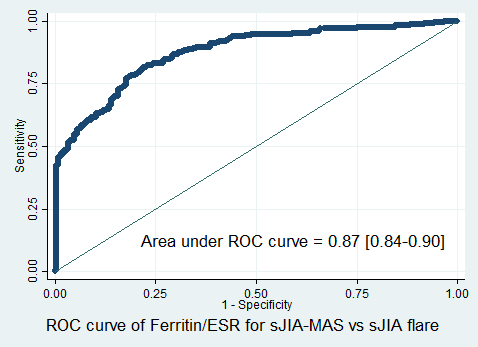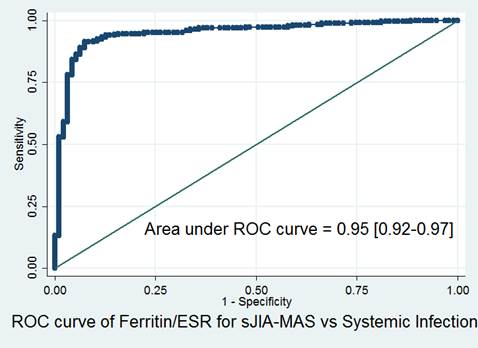Session Information
Date: Monday, November 6, 2017
Title: Pediatric Rheumatology – Clinical and Therapeutic Aspects I: Autoinflammatory Diseases
Session Type: ACR Concurrent Abstract Session
Session Time: 4:30PM-6:00PM
Background/Purpose:
Macrophage activation syndrome (MAS) is a life threatening complication of systemic juvenile idiopathic arthritis (sJIA). As MAS often shares clinical and laboratory features with sJIA disease flare, it can be difficult to distinguish. For new sJIA diagnoses, MAS associated with sJIA (sJIA-MAS) also has to be discerned from infection. A previous study suggested a serum ferritin to erythrocyte sedimentation rate (ESR) ratio of >80 could identify MAS among a small cohort of children with new-onset sJIA (J Rheumatol. 2013;40:1191). As a simple and quick tool, the ferritin to ESR ratio was explored to differentiate sJIA-MAS from active sJIA without MAS (flare), and from hospitalized febrile patients with systemic infections (SI).
Methods:
Data was reviewed from a multinational study of patients with sJIA-MAS (n=362), sJIA flare (n=404), and SI (n=345) (Arthritis Rheumatol. 2014;66:3160). Patients without documented ESR or ferritin were excluded, leaving 262 sJIA-MAS, 262 sJIA flare, and 93 SI. Receiver operating characteristic curves for ferritin/ESR were constructed, and areas under the curves (AUC) were calculated with 95% confidence intervals. The Youden index was used to determine the optimal ferritin/ESR cut-point.
Results:
For the ferritin/ESR ratio, comparing sJIA-MAS vs. sJIA flare, a cut off value of 21.5 had a sensitivity of 0.82 and specificity of 0.78 (AUC: 0.87 [0.84-0.90]). Comparing the ratio in sJIA-MAS cases vs. SI, a cut off value of 11.3 had a sensitivity of 0.91 and specificity of 0.93 (AUC: 0.95 [0.92-0.97]). Comparing sJIA-MAS cases vs. all others (sJIA flare & SI combined), a cut off value of 21.5 had a sensitivity of 0.82 and specificity of 0.83. (AUC: 0.89 [0.87-0.92]).
Conclusion:
The ferritin/ESR ratio with a cut off value of 21.5 accurately distinguishes sJIA-MAS from sJIA flare. This discriminatory ratio performs comparably to and is less complicated than the recent MAS in sJIA classification criteria (Ann Rheum Dis. 2016;75:481). In distinguishing sJIA-MAS from hospitalized infection, a ferritin/ESR ratio of 11.3 was a powerful tool with high sensitivity and specificity. The ferritin/ESR ratio is a quick and simple measure for distinguishing sJIA-MAS from sJIA flare and infection. Future studies should explore the measure in different MAS cohorts.
To cite this abstract in AMA style:
Eloseily EMA, Minoia F, Beukelman T, Ravelli A, Cron RQ. the Ferritin to ESR Ratio: A Simple Measure to Distinguish Macrophage Activation Syndrome from Systemic Arthritis Flare [abstract]. Arthritis Rheumatol. 2017; 69 (suppl 10). https://acrabstracts.org/abstract/the-ferritin-to-esr-ratio-a-simple-measure-to-distinguish-macrophage-activation-syndrome-from-systemic-arthritis-flare/. Accessed .« Back to 2017 ACR/ARHP Annual Meeting
ACR Meeting Abstracts - https://acrabstracts.org/abstract/the-ferritin-to-esr-ratio-a-simple-measure-to-distinguish-macrophage-activation-syndrome-from-systemic-arthritis-flare/


